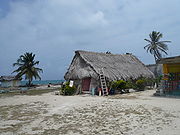Indigenous peoples of Panama
In this article we are going to talk about Indigenous peoples of Panama, a topic that has aroused great interest in recent times. Indigenous peoples of Panama is a broad and diverse topic that covers different aspects, from its history to its practical applications today. Many people have dedicated years of study and research to Indigenous peoples of Panama, which has allowed for greater understanding and development in this field. Throughout this article we will explore the different dimensions of Indigenous peoples of Panama, analyzing its impact on society, its relevance in the scientific and technological field, and the future perspectives that are envisioned around this topic.



Indigenous peoples of Panama, or Native Panamanians, are the native peoples of Panama. According to the 2010 census, they make up 12.3% of the overall population of 3.4 million, or just over 418,000 people. The Ngäbe and Buglé comprise half of the indigenous peoples of Panama.
Many of the Indigenous Peoples live on comarca indígenas, which are administrative regions for areas with substantial Indigenous populations. Three comarcas (Comarca Emberá-Wounaan, Guna Yala, Ngäbe-Buglé) exist as equivalent to a province, with two smaller comarcas (Guna de Madugandí and Guna de Wargandí) subordinate to a province and considered equivalent to a corregimiento (municipality).
Indigenous groups
- Bokota, Bocas Del Toro
- Embera, southeastern Darién Province
- Ngäbe (including the Movere and Murire peoples), mainly Chiriquí Province
- Guna, Darién Province and Caribbean side.
- Buglé, mainly Chiriquí Province
- Talamanca
- Teribe
- Wounaan, southeastern Darién Province
- Emberá-Wounaan, mainly Emberá-Wounaan Comarca
- Bribri
Languages
Some native peoples speak Spanish, while many more retain their traditional languages. According to the 2000 census, the following indigenous languages are spoken in Panama:
- Bokota language: 933 speakers (in Panama)
- Bri-bri language: 2,521 speakers
- Buglé language: 17,731 speakers
- Emberá language: 22,485 speakers
- Guna Language: 61,707 speakers
- Naso-Teribe language: 3,305 speakers
- Ngöbe language: 169,130 speakers
- Wounaan language: 6,882 speakers
Notes
- ^ a b "Panama History: Indigenous People." Archived 2010-11-25 at the Wayback Machine Panama Experts. (retrieved 23 Feb 2011)
- ^ a b "Indigenous Peoples in Panama." Archived 2011-03-02 at the Wayback Machine International Work Group for Indian Affairs. (retrieved 23 Feb 2011)
